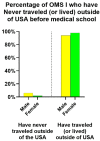Building Interest in the Primary Care Specialty Through Enhanced Global Health Experience
- PMID: 38192912
- PMCID: PMC10773161
- DOI: 10.7759/cureus.50216
Building Interest in the Primary Care Specialty Through Enhanced Global Health Experience
Abstract
Background An overwhelming majority of matriculating medical students in the USA are keen to deliver quality health care to all people, including the socioeconomically disadvantaged populations in remote, resource-scarce regions nationally and worldwide. Here, we describe a protocol developed to evaluate the interest of our medical students in global health activities. We also examined the relationship between students' interest in global health and readiness to pursue a future career in the primary care specialty. Materials and methods We designed a survey in Qualtrics online software and reached all first-year and third-year medical students between 2019 and 2022 enrolled at the Alabama College of Osteopathic Medicine (ACOM). The survey utilized ordinal scale items to explore the medical students' interest in primary care residency programs, their interest in global health and international travel, and their perceptions of how a range of factors might motivate their desire to participate in global health activities. The study was approved by ACOM's Institutional Review Board (IRB). In order to compare findings from this study with data from other medical schools, we developed constructs using the national aggregate data, in percentages, from matriculants and graduates of Doctor of Osteopathic Medicine (DO) degree-granting medical schools according to gender, published by the American Association of Colleges of Osteopathic Medicine (AACOM). Statistical analysis of national aggregate data was performed using the unpaired t-test. Results Both female and male participants had lived or traveled abroad before starting medical school. Female (98%, n=249) and male (95%, n=140) participants in the first-year cohorts considered helping the underserved population as important or very important as it is related to a career in medicine. Females in the third-year cohorts (97%, n=71) also ranked this statement as important or very important compared to male cohorts (89%, n=31). A higher proportion of females (43%, n=108) compared to males (35%, n=52) in first-year cohorts agreed or strongly agreed that they would likely pursue a residency in primary care. More females (59%, n=43) than males (46%, n=16) in the third-year cohorts agreed or strongly agreed with the same statement. Analysis of the aggregate national data (2009-2022) revealed that the percentage (actual count not available) of female students who planned to practice in underserved/shortage area was higher both at the time of matriculation (M=51%, SD=4%) and before graduation (M=40%, SD=4%) compared to males (matriculation: M=40%, SD=5%; graduation: M=33%, SD=4%) presenting a significant difference (matriculation t(24)=6.7, p<0.0001; graduation t(24)=5.4, p<0.0001). Furthermore, a higher percentage of females at the time of matriculation (M=25%, SD=5%) and graduation (M=40%, SD=6%) planned to practice in the primary care specialties compared to males (matriculation: M=17%, SD=4%; graduation: M=29%, SD=6%) presenting a significant difference (matriculation: t(24)=4.6, p = 0.0001; graduation: t(24)=4.8, p<0.0001). Conclusions Interest in global health activities may be associated with interest in pursuing a future career in the primary care specialty. In this study, more female medical students expressed interest in participating in global health experiences, serving the underserved population domestically and abroad, and expressing interest in primary care than males.
Keywords: gender; global health education; higher education medical training; international and travel medicine; primary care.
Copyright © 2023, Hernandez et al.
Conflict of interest statement
The authors have declared that no competing interests exist.
Figures



Similar articles
-
Association of Demographic Factors and Medical School Experiences With Students' Intention to Pursue a Surgical Specialty and Practice in Underserved Areas.JAMA Surg. 2021 Dec 1;156(12):e214898. doi: 10.1001/jamasurg.2021.4898. Epub 2021 Dec 8. JAMA Surg. 2021. PMID: 34613342 Free PMC article.
-
Predictors of Primary Care Practice Among Medical Students at the Michigan State University College of Human Medicine.J Am Board Fam Med. 2022 Mar-Apr;35(2):370-379. doi: 10.3122/jabfm.2022.02.210257. J Am Board Fam Med. 2022. PMID: 35379723
-
Family Medicine Specialty Choice at Matriculation and Graduation.Fam Med. 2025 Apr;57(4):292-297. doi: 10.22454/FamMed.2025.462568. Epub 2025 Mar 7. Fam Med. 2025. PMID: 40272871 Free PMC article.
-
Evolution of Medical Students' Interest in Orthopaedic Surgery Careers from Matriculation to Graduation.JB JS Open Access. 2024 Jul 2;9(3):e24.00019. doi: 10.2106/JBJS.OA.24.00019. eCollection 2024 Jul-Sep. JB JS Open Access. 2024. PMID: 38957705 Free PMC article. Review.
-
From Primary Care to Super Specialty: A Comparison of Workforce Expansion and Capacity Building in Internal Medicine in India and the United States.Cureus. 2025 Jan 10;17(1):e77221. doi: 10.7759/cureus.77221. eCollection 2025 Jan. Cureus. 2025. PMID: 39925598 Free PMC article. Review.
References
-
- The complexities of physician supply and demand: projections from 2019 to 2034. [ Nov; 2023 ]. 2021. https://collections.nlm.nih.gov/catalog/nlm:nlmuid-9918417887306676-pdf https://collections.nlm.nih.gov/catalog/nlm:nlmuid-9918417887306676-pdf
-
- NRMP delivers a strong match to thousands of residency applicants and programs . [ Nov; 2023 ]. 2022. https://www.nrmp.org/about/news/2022/03/nrmp-delivers-a-strong-match-to-... https://www.nrmp.org/about/news/2022/03/nrmp-delivers-a-strong-match-to-...
-
- Medical students' attitudes toward underserved patients: a longitudinal comparison of problem-based and traditional medical curricula. Crandall SJ, Reboussin BA, Michielutte R, Anthony JE, Naughton MJ. Adv Health Sci Educ Theory Pract. 2007;12:71–86. - PubMed
LinkOut - more resources
Full Text Sources
